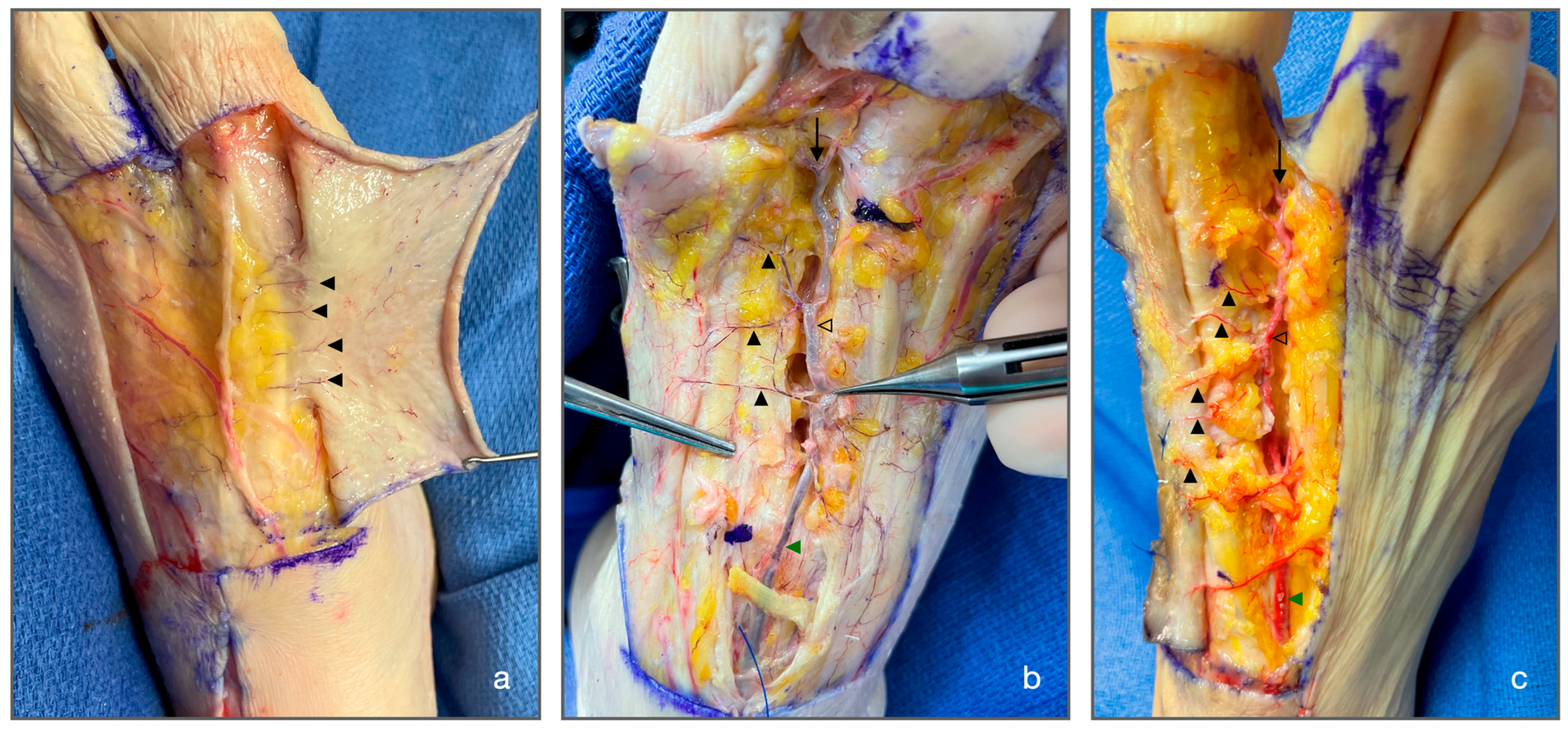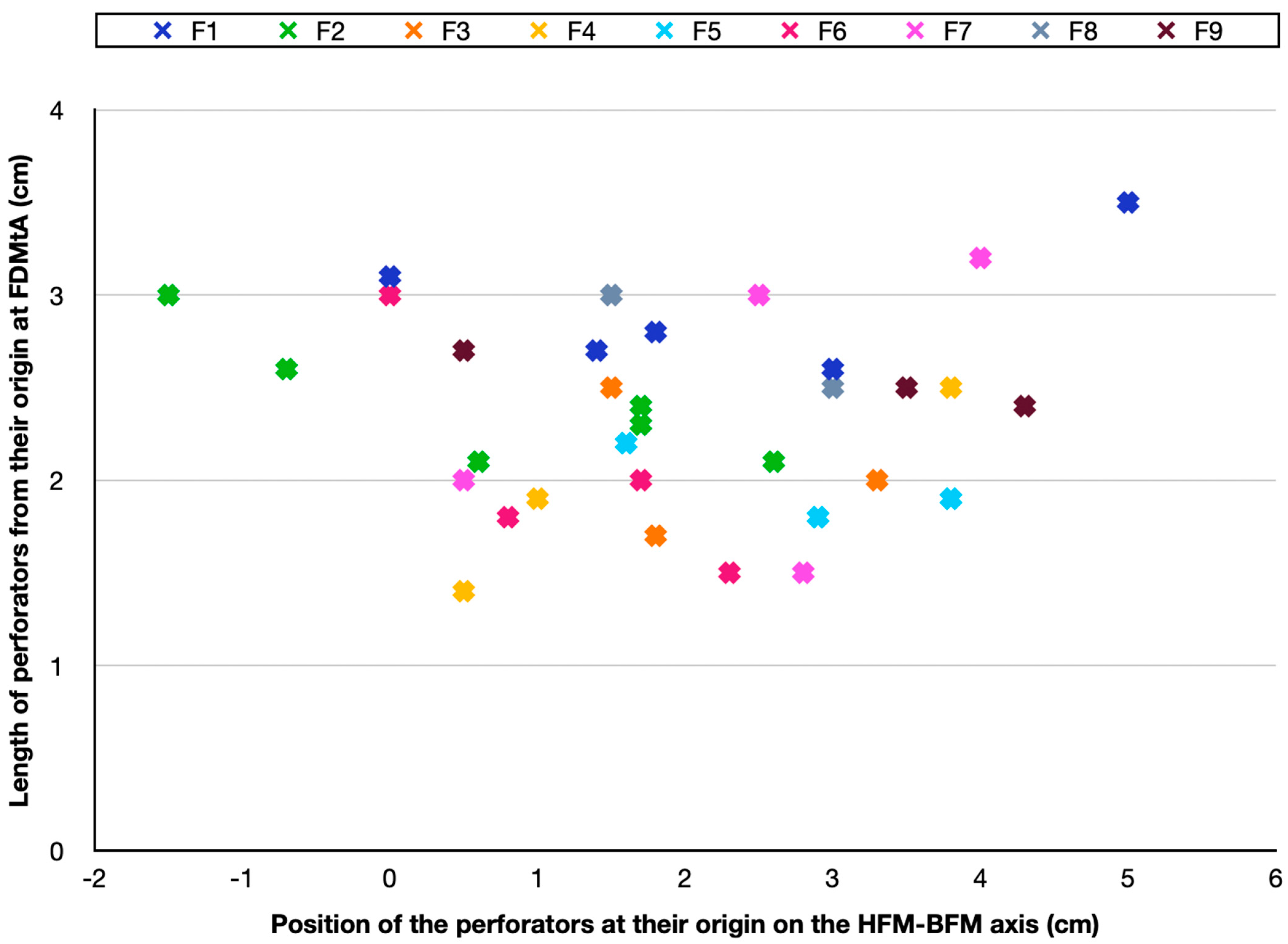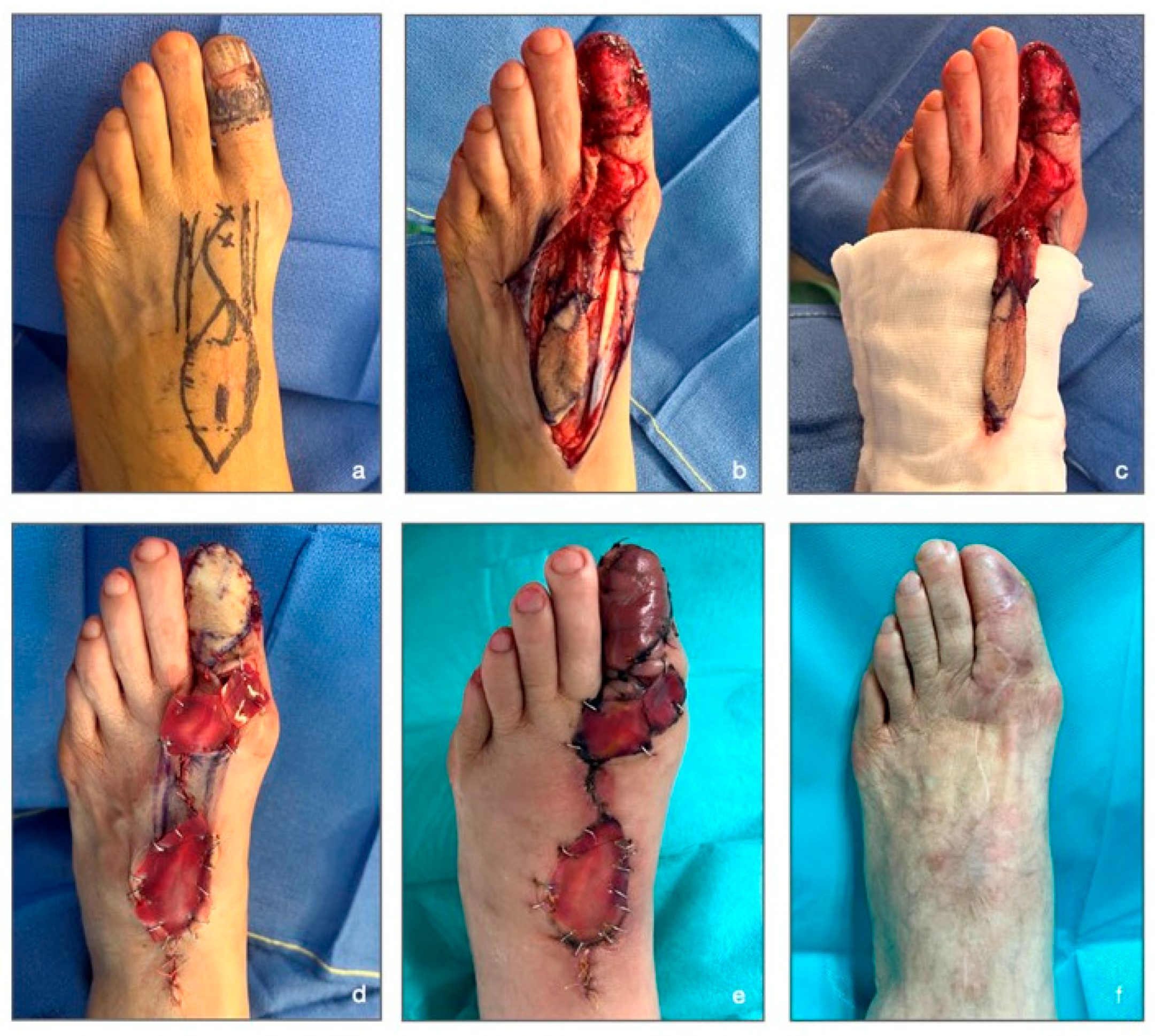The First Dorsal Metatarsal Artery Perforator Flap: A Description and Anatomical Study
Abstract
1. Introduction
2. Materials and Methods
2.1. FDMtA Perforator Mapping
2.2. Clinical Application
3. Results
3.1. Anatomical Description
3.2. Clinical Application
4. Discussion
5. Conclusions
Author Contributions
Funding
Institutional Review Board Statement
Informed Consent Statement
Data Availability Statement
Acknowledgments
Conflicts of Interest
Abbreviations
| FDMtA | First dorsal metatarsal artery |
| FDMtAP | First dorsal metatarsal artery perforator |
| DPA | Dorsal pedis artery |
| HFM | Head of the first metatarsal |
| BFM | Base of the first metatarsal |
| ATA | Anterior tibial artery |
| IHC PRAME | Immunohistochemistry preferentially expressed antigen in melanoma |
| Tis | Tumor in situ |
| AJCC | American Joint Committee on Cancer |
References
- Julien, P.H.; Marcinko, D.E.; Gordon, S. Reconstruction of soft tissue defects about the great toe. J. Foot Surg. 1988, 27, 116–120. [Google Scholar]
- Bernardes, S.S.; Ferreira, I.; Elder, D.E.; Nobre, A.B.; Martínez-Said, H.; Adams, D.J.; Robles-Espinoza, C.D.; Possik, P.A. More than just acral melanoma: The controversies of defining the disease. J. Pathol. Clin. Res. 2021, 7, 531–541. [Google Scholar] [CrossRef] [PubMed]
- Hall, K.H.; Rapini, R.P. Acral Lentiginous Melanoma. In StatPearls; StatPearls Publishing: Treasure Island, FL, USA, 2024. Available online: http://www.ncbi.nlm.nih.gov/books/NBK559113/ (accessed on 17 April 2024).
- Hou, Z.; Zou, J.; Wang, Z.; Zhong, S. Anatomical classification of the first dorsal metatarsal artery and its clinical application. Plast. Reconstr. Surg. 2013, 132, 1028e–1039e. [Google Scholar] [CrossRef] [PubMed]
- Lee, J.H.; Dauber, W. Anatomic study of the dorsalis pedis-first dorsal metatarsal artery. Ann. Plast. Surg. 1997, 38, 50–55. [Google Scholar] [CrossRef]
- Vazquez, T.; Rodríguez-Niedenfuhr, M.; Parkin, I.; Viejo, F.; Sanudo, J. Anatomic Study of Blood Supply of the Dorsum of the Foot and Ankle. Arthrosc. J. Arthrosc. Relat. Surg. 2006, 22, 287–290. [Google Scholar] [CrossRef]
- St-Laurent, J.Y.; Lanzetta, M. Resurfacing of the donor defect after wrap-around toe transfer with a free lateral forearm flap. J. Hand Surg. Am. 1997, 22, 913–917. [Google Scholar] [CrossRef]
- Roukis, T.S.; Landsman, A.S. A simple salvage technique for single-stage, soft-tissue coverage of plantar first metatarsal head ulcerations and ablation of great toe osteomyelitis. Plast. Reconstr. Surg. 2004, 113, 1098–1100. [Google Scholar] [CrossRef]
- Butler, C.E.; Chevray, P. Retrograde-flow medial plantar island flap reconstruction of distal forefoot, toe, and webspace defects. Ann. Plast. Surg. 2002, 49, 196–201. [Google Scholar] [CrossRef] [PubMed]
- Giraldo, F.; De Haro, F.; Ferrer, A. Opposed transverse extended V-Y plantar flaps for reconstruction of neuropathic metatarsal head ulcers. Plast. Reconstr. Surg. 2001, 108, 1019–1024. [Google Scholar] [CrossRef]
- Hallock, G.G. Distally based flaps for skin coverage of the foot and ankle. Foot Ankle Int. 1996, 17, 343–348. [Google Scholar] [CrossRef]
- Senyuva, C.; Yucel, A.; Fassio, E.; Cetinkale, O.; Goga, D. Reverse first dorsal metatarsal artery adipofascial flap. Ann. Plast. Surg. 1996, 36, 158–161. [Google Scholar] [CrossRef]
- Samson, M.C.; Morris, S.F.; Tweed, A.E. Dorsalis pedis flap donor site: Acceptable or not? Plast. Reconstr. Surg. 1998, 102, 1549–1554. [Google Scholar] [CrossRef] [PubMed]
- Pignatti, M.; Ogawa, R.; Hallock, G.G.; Mateev, M.; Georgescu, A.V.; Balakrishnan, G.; Ono, S.; Cubison, T.; D’Arpa, S.; Koshima, I.; et al. The ‘Tokyo’ consensus on propeller flaps. Plast. Reconstr. Surg. 2011, 127, 716–722. [Google Scholar] [CrossRef] [PubMed]
- Pignatti, M.; Ogawa, R.; Mateev, M.; Georgescu, A.V.; Balakrishnan, G.; Ono, S.; Cubison, T.; Pinto, V.; D’Arpa, S.; Koshima, I.; et al. Our Definition of Propeller Flaps and Their Classification. Semin. Plast. Surg. 2020, 34, 139–144. [Google Scholar] [CrossRef]
- Limthongthang, R.; Eamsobhana, P. First dorsal metatarsal artery perforator flap to cover great toe defect. J. Orthop. Surg. 2017, 25, 2309499017739497. [Google Scholar] [CrossRef] [PubMed]
- Hallock, G.G. The First Dorsal Metatarsal Artery Perforator Propeller Flap. Ann. Plast. Surg. 2016, 76, 684–687. [Google Scholar] [CrossRef]
- Khan, W.; Loh, C.Y.Y.; Gkorgkolis, V.; El-Muttardi, N. Dorsal Metatarsal Artery Perforator (DMtAP) flap Reconstruction of the Foot—A Review. JPRAS Open 2020, 26, 37–42. [Google Scholar] [CrossRef]
- Zhang, W.; Rebosura, C.K.P.; Tong, P.Y.; Rajaratnam, V. First Dorsal Metatarsal Artery Flap for Coverage of Distal Foot Wounds: A Case Discussion and Narrative Review. Tech. Foot Ankle Surg. 2021, 20, 216–221. [Google Scholar] [CrossRef]
- Tanaka, K.; Nakamura, Y.; Mizutani, T.; Shibata, T.; Tsutsumida, A.; Fukuda, H.; Matsushita, S.; Aoki, M.; Namikawa, K.; Ohe, S.; et al. Confirmatory trial of non-amputative digit preservation surgery for subungual melanoma: Japan Clinical Oncology Group study (JCOG1602, J-NAIL study protocol). BMC Cancer 2019, 19, 1002. [Google Scholar] [CrossRef]
- Swetter, S.M.; Tsao, H.; Bichakjian, C.K.; Curiel-Lewandrowski, C.; Elder, D.E.; Gershenwald, J.E.; Guild, V.; Grant-Kels, J.M.; Halpern, A.C.; Johnson, T.M.; et al. Guidelines of care for the management of primary cutaneous melanoma. J. Am. Acad. Dermatol. 2019, 80, 208–250. [Google Scholar] [CrossRef]
- Emsen, I.M. Reconstruction with distally based dorsalis pedis fasciocutaneous flap for the coverage of distal toe-plantar defects. Can. J. Plast. Surg. 2012, 20, 25–27. [Google Scholar] [CrossRef]
- Le, M.; Gabrielli, S.; Zloty, D. Mohs Micrographic Surgery Is Equivalent to Nail Unit Excision or Amputation for Melanoma In Situ of the Nail Unit: A Systematic Review and Meta-Analysis. Dermatol. Surg. 2023, 49, 755–758. [Google Scholar] [CrossRef] [PubMed]
- Kim, T.G.; Choi, M.K. Secondary contouring of flaps. Arch. Plast. Surg. 2018, 45, 319–324. [Google Scholar] [CrossRef]
- Lee, K.T.; Park, B.Y.; Kim, E.J.; Kim, J.H.; Jang, K.T.; Choi, S.H.; Lee, D.-Y.; Mun, G.-H. Superthin SCIP Flap for Reconstruction of Subungual Melanoma: Aesthetic Functional Surgery. Plast. Reconstr. Surg. 2017, 140, 1278–1289. [Google Scholar] [CrossRef] [PubMed]
- Jakubietz, R.G.; Jakubietz, M.G.; Gruenert, J.G.; Kloss, D.F. The 180-degree perforator-based propeller flap for soft tissue coverage of the distal, lower extremity: A new method to achieve reliable coverage of the distal lower extremity with a local, fasciocutaneous perforator flap. Ann. Plast. Surg. 2007, 59, 667–671. [Google Scholar] [CrossRef]
- Fu, D.; Zhou, L.; Yang, S.; Xiao, B. Surgical technique: Repair of forefoot skin and soft tissue defects using a lateral tarsal flap with a reverse dorsalis pedis artery pedicle: A retrospective study of 11 patients. Clin. Orthop. Relat. Res. 2013, 471, 317–323. [Google Scholar] [CrossRef][Green Version]
- Gupta, R.; Pfennig, M.; Gannon, J.; Young, D.; Gupta, R.; Hart, J.; Kissel, B.G.; Kissel, E.C.; Fortin, P.; Chaiyasate, K. Utilization of the Free Fibular Flap for First Metatarsal Reconstruction. Plast. Reconstr. Surg. Glob. Open 2022, 10, e4706. [Google Scholar] [CrossRef]




| Analysis of the First Dorsal Metatarsal Artery Perforators (FDMtAPs) | ||||||
|---|---|---|---|---|---|---|
| Specimen No. | Foot (n) | Side | Mean Number of FDMtAPs (n) | Mean Length of FDMtAPs (cm) | Mean Proximal Diameter of FDMtAPs (mm) | Mean Distal Diameter of FDMtAPs (mm) |
| 1 | f1 | L | 5 | 2.94 | 0.17 | 0.11 |
| 2 | f2 | R | 6 | 2.42 | 0.13 | 0.11 |
| 2 | f3 | L | 3 | 2.07 | 0.16 | 0.1 |
| 3 | f4 | L | 3 | 1.94 | 0.16 | 0.1 |
| 4 | f5 | L | 3 | 1.96 | 0.19 | 0.12 |
| 4 | f6 | R | 4 | 2.07 | 0.22 | 0.12 |
| 5 | f7 | R | 4 | 2.42 | 0.16 | 0.1 |
| 6 | f8 | R | 2 | 2.75 | 0.25 | 0.12 |
| 7 | f9 | L | 3 | 2.53 | 0.16 | 0.11 |
| Mean | — | — | 3.67 | 2.35 | 0.178 | 0.110 |
| SD | — | — | 1.23 | 0.36 | 0.037 | 0.008 |
Disclaimer/Publisher’s Note: The statements, opinions and data contained in all publications are solely those of the individual author(s) and contributor(s) and not of MDPI and/or the editor(s). MDPI and/or the editor(s) disclaim responsibility for any injury to people or property resulting from any ideas, methods, instructions or products referred to in the content. |
© 2025 by the authors. Licensee MDPI, Basel, Switzerland. This article is an open access article distributed under the terms and conditions of the Creative Commons Attribution (CC BY) license (https://creativecommons.org/licenses/by/4.0/).
Share and Cite
Saboye, M.; Majchrzak, A.; d’Andréa, G.; Bronsard, N.; Camuzard, O.; Lupon, E. The First Dorsal Metatarsal Artery Perforator Flap: A Description and Anatomical Study. J. Clin. Med. 2025, 14, 4136. https://doi.org/10.3390/jcm14124136
Saboye M, Majchrzak A, d’Andréa G, Bronsard N, Camuzard O, Lupon E. The First Dorsal Metatarsal Artery Perforator Flap: A Description and Anatomical Study. Journal of Clinical Medicine. 2025; 14(12):4136. https://doi.org/10.3390/jcm14124136
Chicago/Turabian StyleSaboye, Mathilde, Alexis Majchrzak, Grégoire d’Andréa, Nicolas Bronsard, Olivier Camuzard, and Elise Lupon. 2025. "The First Dorsal Metatarsal Artery Perforator Flap: A Description and Anatomical Study" Journal of Clinical Medicine 14, no. 12: 4136. https://doi.org/10.3390/jcm14124136
APA StyleSaboye, M., Majchrzak, A., d’Andréa, G., Bronsard, N., Camuzard, O., & Lupon, E. (2025). The First Dorsal Metatarsal Artery Perforator Flap: A Description and Anatomical Study. Journal of Clinical Medicine, 14(12), 4136. https://doi.org/10.3390/jcm14124136






